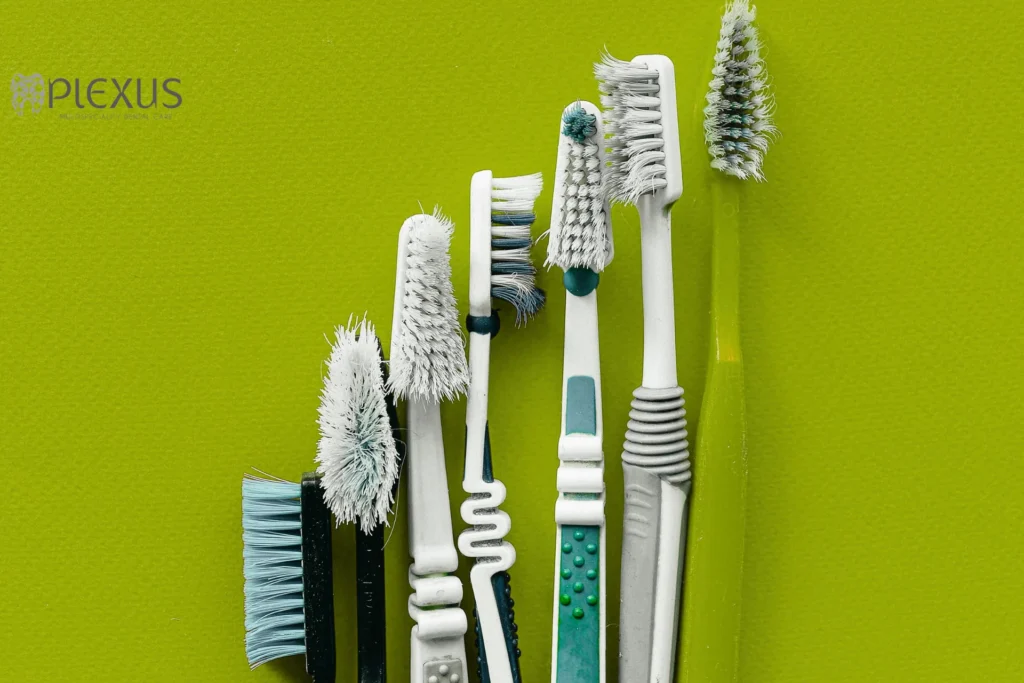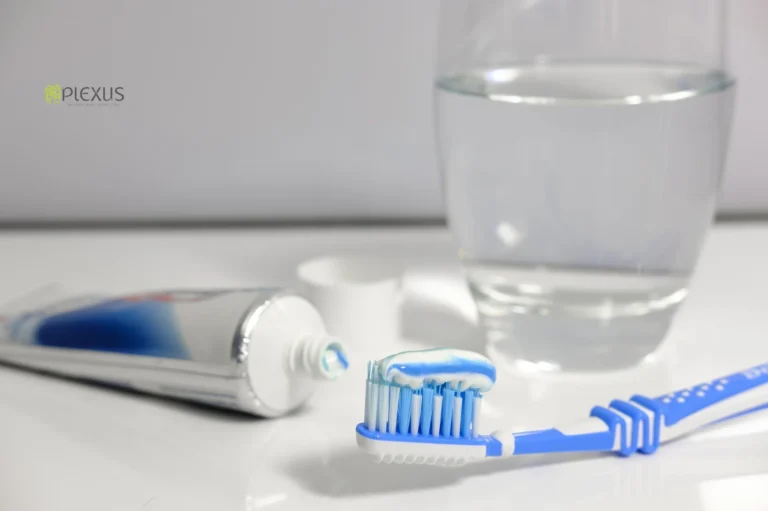In today’s modern world, there is an increasing focus on one’s aesthetic appearance . For which extra care and makeover is given to hair , skin, nails and teeth!!!
With increasing awareness for the importance of teeth and a glowing smile, it is not very uncommon to find people brushing twice a day to maintain their teeth. But did you know that this little soldier (toothbrush) of yours requires frequent changing ,which if not done can do more harm than help!! So the real question is exactly how frequently should you change your toothbrush?
Let’s hear what our Smile expert Dr.Esha has to say on this.
Table of Contents
Brushing your way to a healthy smile
A simple thing like a toothbrush can save you from the pain on your teeth and pockets. Toothbrush helps mechanically clean the surfaces of teeth thus removing plaque, stains and 0l food particles . Therefore preventing cavities and gum problems. Though other dental materials like floss, interdental brush, water flosser etc also help maintaining oral hygiene; these only act as an adjuvant and not a replacement to brushing. A toothbrush used for a long time has reduced efficiency to clean and increased abrasion to teeth. Therefore it’s very important to know when to change your toothbrush. At Plexus Dental Studio we offer comprehensive dental solutions to maintain your oral health and confidence.
How Often Should You Really Change Toothbrush?
 According to the American Dental Association(ADA), toothbrushes should be changed after every 3-months. But recent studies suggest that, rather than the age of toothbrush, the degree of wear to the toothbrush is the factor that determines when your toothbrush needs to be changed.
According to the American Dental Association(ADA), toothbrushes should be changed after every 3-months. But recent studies suggest that, rather than the age of toothbrush, the degree of wear to the toothbrush is the factor that determines when your toothbrush needs to be changed.
Why Changing Your Toothbrush Matters More Than You Think?
Regularly changing your brush not only protects your teeth from cavities but also helps preserve your natural shine. For those struggling with dullness or discoloration, explore our Teeth Whitening in Andheri West service for a brighter, more confident smile.
1. Perfect home for bacterial buildup:
A wet toothbrush harbours a lot of bacteria and proves to be an excellent environment for their growth. A toothbrush used for a long time has a number of disease-causing bacteria.
2. Tooth wear and gum problems:
Damaged bristles due to overuse or forceful brushing has deteriorating effects on the tooth. Tooth wear and gum damage increases due to this. Gum problems in the form of inflammation or bleeding become common. Severe tooth wear can lead to severe sensitivity and in the worst case might even go for root canal or extraction.
3. Loss of confidence:
Prolonged tooth wear has an effect on the overall smile. Your confidence drops down due to a dull smile. Tooth abrasion and gum inflammation/ bleeding can make the smile unattractive.
Clear Signs It’s Time To Change Your Toothbrush

- Frayed or flattening of bristles
- Softening of bristles
- Unpleasant odour from toothbrush
- Sludge build-up at the base of toothbrush
- Tooth wear
- Gum bleeding / Gum injury
- Reduced cleaning efficiency
If you’re using an electric brush, ensure timely replacement every 3 months. You can also combine your oral hygiene routine with professional whitening options like our Teeth Whitening in Mumbai treatment for lasting sparkle. Using an old brush also accelerates gum wear and can worsen dental sensitivity. In severe wear cases, Dental Implants Explained is an excellent guide to understanding advanced tooth restoration options.
Electric Toothbrush vs. Manual : What’s Better for Your Smile?
How Often Should You Replace Electric Brush Heads?
Electric Toothbrushes also require maintenance . Overtime use can lead to spraying of bristles due to the brushes oscillatory and vibratory movements. This calls for replacement of the brush head to a new one. As mentioned previously, fraying of bristles, odour, softening of bristles and damage to tooth and gums are indication for head change.
Do Electric Toothbrushes Clean Better?
Various studies have proven that if used correctly electric toothbrushes proves to have better efficiency than manual toothbrushes in removing plaque and stains. Electric toothbrushes have programmed oscillating and vibratory movements that help in better cleaning. Even though an electric toothbrush has its own movements, it is still required to carefully place the brush head at the proper position on the tooth surface and monitor hand movements. Electric toothbrushes are an excellent option in patients with braces or reduced hand dexterity due to old age, neuromuscular disease etc.
Choosing the Right Brush for You
Plexus Dental Studio helps you find out the best type of toothbrush suitable for you. Irrespective of the type of brush or method of brushing, your toothbrush should always have soft/ultra soft bristles. Hard bristles cause more damage to tooth and gums.
| Feature | Manual Toothbrush | Electric Toothbrush |
|---|---|---|
| Cleaning Efficiency | Depends on technique | Consistent oscillating motion ensures deep cleaning |
| Ease of Use | Requires proper brushing motion | Ideal for people with braces or limited mobility |
| Cost | Affordable and easily available | Higher upfront cost + periodic head replacements |
| Replacement Frequency | Every 3 months | Replace brush head every 3 months |
| Ideal For | Children, travelers, basic oral hygiene | Adults, elderly, or those with braces |
How to Keep Your Toothbrush Clean Between Replacements?

Daily Hygiene Habits
- Rinse your brush after use.
- Shake off excess water.
- Place it upright to air dry.
- Keep separate from other brushes.
What Not to Do
- Don’t cover with caps — does not allow air to dry.
- Avoid placing them near toilets.
- Replacing after illness .
- Avoid storing in damp/ humid places.
Tooth abrasion and gum diseases associated with damaged toothbrushes are irreversible. These issues might initially seem insignificant, but over a period of time these turn to make your smile unappealing. In the worst cases of severe tooth wear , tooth loss can also occur. Intervention in early cases can help by having the tooth filled or gum cleaning.
A small step towards your dental care will save you from future dental pain, treatment expense and time-loss. Just like you would change your phone for better features, why not change your brush for a better, beautiful and radiant smile.
Our Smile expert Dr. Esha suggests discussing with your dentist regarding your brushing habits, method and dental concerns to help you choose the best toothbrush .Let Plexus Dental Studio guide you with the right toothbrush and correct brushing technique to help you maintain your sparkling smile. A small step like replacing your brush on time can save you from long-term dental pain, costs, and dull smiles. Want personalized advice? Contact Plexus Dental Studio to book your consultation with Dr. Esha today.
FAQs
What’s the Best Type of Brush for Sensitive Gums?
A hard or frayed bristle toothbrush is very harsh even on normal gums. This can lead to gum recession and bleeding . In general, always use an ultra soft/soft bristle toothbrush which is gentle on your gums.
Can I Disinfect and Reuse an Old Toothbrush?
Disinfecting your toothbrush might reduce the bacterial load and foul odour to some extent. But no effects will be seen in cases of tooth abrasion and gum problem due to toothbrush fraying.
Is an Electric Toothbrush Worth the Investment?
As concluded from some studies, electric toothbrushes if used properly have better plaque removal efficiency than manual toothbrushes. On the other hand, an electric toothbrush proves to be expensive considering that it requires battery and head change at regular intervals. Therefore, the choice to invest totally depends on the brushing technique and paying capability of a particular individual. Discuss with your dentist whether an electric toothbrush would be better for you.
